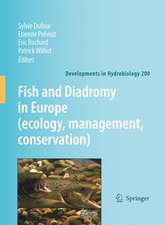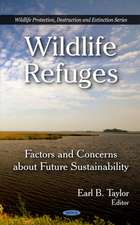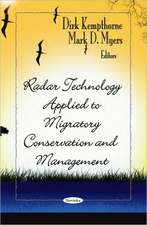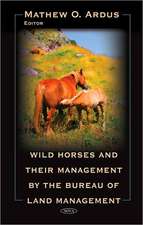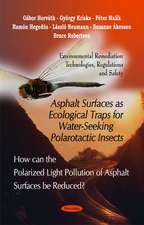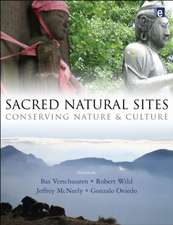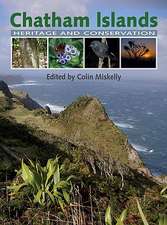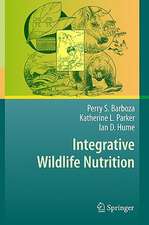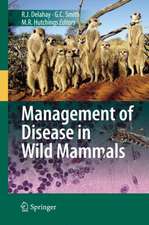The Siberian Sturgeon (Acipenser baerii, Brandt, 1869) Volume 2 - Farming
Editat de Patrick Williot, Guy Nonnotte, Mikhail Chebanoven Limba Engleză Hardback – 25 apr 2018
| Toate formatele și edițiile | Preț | Express |
|---|---|---|
| Paperback (1) | 1236.99 lei 3-5 săpt. | |
| Springer International Publishing – 8 ian 2019 | 1236.99 lei 3-5 săpt. | |
| Hardback (1) | 1410.45 lei 3-5 săpt. | |
| Springer International Publishing – 25 apr 2018 | 1410.45 lei 3-5 săpt. |
Preț: 1410.45 lei
Preț vechi: 1720.07 lei
-18% Nou
Puncte Express: 2116
Preț estimativ în valută:
269.92€ • 293.10$ • 226.73£
269.92€ • 293.10$ • 226.73£
Carte disponibilă
Livrare economică 01-15 aprilie
Preluare comenzi: 021 569.72.76
Specificații
ISBN-13: 9783319616742
ISBN-10: 3319616749
Pagini: 619
Ilustrații: XVIII, 590 p. 231 illus., 164 illus. in color.
Dimensiuni: 155 x 235 mm
Greutate: 1.29 kg
Ediția:1st ed. 2018
Editura: Springer International Publishing
Colecția Springer
Locul publicării:Cham, Switzerland
ISBN-10: 3319616749
Pagini: 619
Ilustrații: XVIII, 590 p. 231 illus., 164 illus. in color.
Dimensiuni: 155 x 235 mm
Greutate: 1.29 kg
Ediția:1st ed. 2018
Editura: Springer International Publishing
Colecția Springer
Locul publicării:Cham, Switzerland
Cuprins
Part I: Reproduction and Early Ontogenesis.- Reproductive Cycles in Sturgeons with a Special Focus on the Farmed Siberian Sturgeon.- Controlled Reproduction of Farmed Siberian Sturgeon Acipenser Baerii Brandt.- Siberian Sturgeon Sperm Cryoconservation.- Weaning in Siberian Sturgeon Larvae.- Part II: Ongrowing.- Food and Feeding: Food Characteristics and Feeding Management on Sturgeon with a Special Focus on the Siberian Sturgeon.- Reasons and Possibilities of Fish Meal Replacement in the Siberian Sturgeon.- Endocrine Disruption in the Siberian Sturgeon Acipenser Baerii Fed a Soy Containing Diet.- Pre-Probiotics and Immunostimulants in the Siberian Sturgeon: Gut Microbiota and Immunomodulation.- Excretion: Nitrogen Excretion in Sturgeons with Special Emphasis on the Siberian Sturgeon: Methods, Effects of Food, Feeding and Size.- Part III. Production: Caviars: How To Describe And Compare Their Qualities?.- The Sensorial Approach: The Off Flavors Management in the Production of Farmed Sturgeon.- Fingerlings for Restocking: Artificial Reproduction of Siberian Sturgeon Fingerlings for Restocking the Siberian Rivers of the Ob-Irtysh Basin: A Synthesis.- Production: An Assessment of the Characteristics of World Production of Siberian Sturgeon Destined to Human Consumption.- Part IV: Long-Term Management of Brood Stock.- Hybrids with the Siberian Sturgeon.- Sex Control: Genome Manipulation and Sex Control in the Siberian Sturgeon: An Updated Synthesis with Regard to Objectives, Constraints and Findings.- Genetics: Genetic Variability in Farmed Brood Stocks of the Siberian in Poland.- Genetic Variability in Farmed Brood Stocks of the Siberian Sturgeon in Russia.- Part IV: State of Health.- Immunology: Immunology In Sturgeons with a Focus on the Siberian Sturgeon Mechanisms, Responses to Stress and Stimulation.- Welfare: Welfare in the Cultured Siberian Sturgeon, Acipenser Baerii Brandt: State of the Art.- The Plasmatic Indicators of the Welfare of Juveniles Siberian Sturgeon.- Part V: Ecological Risks.- Synthesis of Introduction Trials of Siberian Sturgeon in North European Part of Russia.- Synthesis of Escapements of Farmed Siberian Sturgeon in French Catchments: Some Extreme Events and a Lot Punctual Accidents.- Part VI: Specific Methods.- In Vitro Incubation of Ovarian Follicles of Cultured Siberian Sturgeon, Acipenser Baerii Brandt: A Short Practical Implementation and Its Fundamentals.- Echography for Siberian Sturgeon Brood Stock Management.- Oxygen Demand in Sturgeon Farming.- General Conclusions on Volume 2: Which Future for the Siberian Sturgeon Farming?
Notă biografică
Patrick Williot
Patrick took on the challenge of preventing the disappearance of the critically endangered European sturgeon and developing sturgeon farming. To do so, he mobilized all the means of research, including the use of biological models of the Siberian sturgeon. He was the kingpin of the First International Symposium on Sturgeon held in Bordeaux in 1989. In 2007, he succeeded in achieving the controlled reproduction of farmed European sturgeon for the first time. He has strongly supported Siberian sturgeon farming in France. Patrick has edited several peer-reviewed books and proceedings on aquaculture and conservation biology, mainly on sturgeon, and published over 90 papers in peer-reviewed journals or books.
Guy Nonotte
Researcher at the CNRS, with a PhD from the University of Strasbourg, Guy NONNOTTE has pursued research on fish physiology i.e. ionic regulation, respiration, extracellular acid-base balance and cell volume regulationin freshwater and sea-water fishes exposed to environmental changes and pollutants with a specific interest in the model « Siberian sturgeon ». He supervised a thesis on the toxicity of ammonia for the Siberian sturgeon in collaboration with Dr. Patrick Williot. In 1994, he was appointed Professor of Animal Physiology at the University of Brest (France) and Emeritus Professor of this University in 2007. He has published more than 100 articles in international reviews and supervised numerous theses on fish ecophysiology.
Mikhail Chebanov
Dr.Sc., Professor at the Aquatic Bioresources and Aquaculture Department of Kuban State University and Director of State Centre for Sturgeon Gene Pool Conservation, Russia. He received an award from the Government of Russia in Science for developing technology for the year-round reproduction of sturgeon and for the global implementation of ultrasound for breeding stock management. He served as consultant FAO, convener of the Management of Sturgeons Working Party EIFAC - FAO, deputy chair and member of the IUCN Sturgeon Specialists Group. Chebanov is co-founder and member of the World Sturgeon Conservation Society board of directors. He has chaired numerous International workshops and symposia sessions.
Patrick took on the challenge of preventing the disappearance of the critically endangered European sturgeon and developing sturgeon farming. To do so, he mobilized all the means of research, including the use of biological models of the Siberian sturgeon. He was the kingpin of the First International Symposium on Sturgeon held in Bordeaux in 1989. In 2007, he succeeded in achieving the controlled reproduction of farmed European sturgeon for the first time. He has strongly supported Siberian sturgeon farming in France. Patrick has edited several peer-reviewed books and proceedings on aquaculture and conservation biology, mainly on sturgeon, and published over 90 papers in peer-reviewed journals or books.
Guy Nonotte
Researcher at the CNRS, with a PhD from the University of Strasbourg, Guy NONNOTTE has pursued research on fish physiology i.e. ionic regulation, respiration, extracellular acid-base balance and cell volume regulationin freshwater and sea-water fishes exposed to environmental changes and pollutants with a specific interest in the model « Siberian sturgeon ». He supervised a thesis on the toxicity of ammonia for the Siberian sturgeon in collaboration with Dr. Patrick Williot. In 1994, he was appointed Professor of Animal Physiology at the University of Brest (France) and Emeritus Professor of this University in 2007. He has published more than 100 articles in international reviews and supervised numerous theses on fish ecophysiology.
Mikhail Chebanov
Dr.Sc., Professor at the Aquatic Bioresources and Aquaculture Department of Kuban State University and Director of State Centre for Sturgeon Gene Pool Conservation, Russia. He received an award from the Government of Russia in Science for developing technology for the year-round reproduction of sturgeon and for the global implementation of ultrasound for breeding stock management. He served as consultant FAO, convener of the Management of Sturgeons Working Party EIFAC - FAO, deputy chair and member of the IUCN Sturgeon Specialists Group. Chebanov is co-founder and member of the World Sturgeon Conservation Society board of directors. He has chaired numerous International workshops and symposia sessions.
Textul de pe ultima copertă
The Siberian sturgeon, Acipenser baerii Brandt 1869 is the most widely farmed sturgeon species. Continuing from Volume 1, which focuses on the biology of the species, the present Volume 2 in turn examines farming aspects. It is divided into six parts, the first of which deals with reproduction and early ontogenesis, i.e. reproductive cycles, controlled reproduction, sperm cryoconservation, and weaning of larvae. The second covers the growing phase with a focus on food and feeding (management, fish meal replacement, potential endocrine disruptions, usefulness of prebiotics and immunostimulants, and nitrogen excretion). Production-related data are the focus of the third part and include: characteristics (countries, structures of production, evolution in production, economic features) of the gross production of the species (meat and caviar) worldwide, a method for assessing the quality of caviars, off-flavors management, and an example of production of fingerlings for restocking. Part four addresses selected long-term management issues: genetic variability of brood stocks, genome manipulation and sex control, and the advantages of hybrids. The next three chapters constitute the fifth part, which is devoted to health status (immunology and welfare). In closing, the absence of ecological risks of introducing the species in non-native waters is shown using two long-term documented examples (Russia and France). Three methodological chapters round out the volume, covering: in vitro incubation of ovarian follicles, a richly illustrated library of echographies and photos, and a detailed presentation of oxygen demand studies.
Caracteristici
gement, genotyping, and veterinary medicine for fish Provides comprehensive information on sturgeon farming, including: Reproduction, Food and Feeding, Long-term Management of Brood Stock, State of Health, and Ecological Risks Shares detailed insights on unusual topics and/or updated syntheses, e.g. controlled reproduction and related issues, fish meal replacement, endocrine disruptions, prebiotics and immunostimulants, off-flavor management, global production of meat and caviar, hybrids, welfare, immunology, ecological risks of installation, as well as selected methods (in vitro incubation of ovarian follicles, richly illustrated library of echographs allowing non-invasive in vivo exploration, oxygen demand) Intended for sturgeon farmers, field technicians, sturgeon biologists, veterinarians, teachers in aquaculture and fisheries, people dealing with administrative management of aquaculture and fisheries, and consultants in a variety of fields, e.g. aquaculture, audits in sturgeon farming, farming design, water mana


